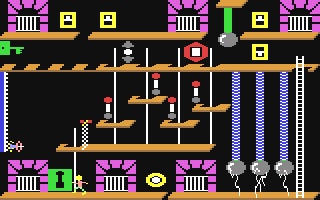Overview
 An intricate room of puzzles & contraptions
An intricate room of puzzles & contraptionsThe Castles of Doctor Creep is a single-screen level puzzle game that has the player escaping from 13 different castles that are filled with traps, monsters, and mazes. Each castle is a series of connected rooms that the player must travel through; many rooms have multiple entrances and exits. In some of the more intricate castles, the player must visit certain rooms multiple times, entering and exiting using different doors. All of the castles can be attempted either solo, or by two players playing cooperatively.
Gameplay
The player moves their character through the 2D levels using a number of different methods, traversing the various obstacles and enemies within the rooms to reach an exit door. The elements & contraptions found in the game that will help or hinder the player are:
Doors
Doors lead to other rooms, and each room contains at least two doors, but often many more. Normal doors are opened by doorbells, but others are locked, and the player must first pick up a key to unlock them.
Ladders & Poles
Players can travel to higher and lower floors in a room using ladders and sliding poles. The ladders allow players to go either up or down, while poles only allow the player to slide down.
Moving Sidewalk
This is a conveyor belt along the ground that allows the player to only travel in one direction, left or right. A switch allows these to be toggled to reverse direction, or be turned off completely.
Trap Door
These trap doors are openings in the floor that are toggled by a switch. They cannot be traversed when open. If a player (or enemy) is standing on them when they are opened, they are killed.
Matter Transporter
This is a teleporter booth that allows the player to instantly travel to another part of the room. Some rooms have teleporters that allow travel to multiple parts of the room, which are selected with color coded receptors.
Force Field
These vertical walls block the path of the player, but can be temporarily turned off for eight seconds using the corresponding switch.
Lightning Machine
These hang from the ceiling and emit lightning that blocks the path of the player. Deadly to the touch, these can be toggled on/off with a switch.
Ray Gun
These automated guns are mounted on the wall, and will track the player while they are in the room. Once they reach the same level of the player, they will fire. These guns can be controlled by the player if they can reach the control panel for them.
Mummy
Mummies start out hidden in their crypt, which looks like a brick wall. Each crypt has an ankh associated with it, and when the player walks past the ankh, the mummy is released. Mummies will chase the player as long as they are in that room, but mummies cannot use ladders or poles.
Frankenstein Monster
Frankenstein Monsters start off in an upright coffin, and will emerge from it and chase the player as soon as they directly face coffin, regardless of distance. Frankenstein Monsters pose a greater risk, because not only are they faster than mummies, they can also use ladders and poles.
Other Gameplay Tidbits
- Both Mummies and Frankenstein Monsters are susceptible to the same dangers as the player, i.e. they can be killed with ray guns, lightning, trap doors, etc.
- Rooms do not reset when re-entered. In fact, everything stays in the exact place it was the moment the player left the room; enemies remain in the locations they were, trap doors remain open/shut, etc. This is actually a critical gameplay element for navigating some of the rooms.
- Every time a room is entered/exited, the game shows a castle map of all the rooms that have been visited so far. As the player progresses, they get a better & better view of how the castle is laid out, how the rooms are connected, and their eventual path to the castle's exit.
Levels
The game contains 13 castles to choose from, each varying in the amount of rooms & difficulty:
- Sylvania - 16 rooms
- Callanwolde - 24 rooms
- Tannenbaum - 10 rooms
- Alternation - 16 rooms
- Freedonia - 5 rooms
- Carpathia - 18 rooms
- Parthenia - 16 rooms
- Teasdale - 16 rooms
- Rittenhouse - 19 rooms
- Romania - 16 rooms
- Doublecross - 15 rooms
- Baskerville - 18 rooms
- Lovecraft - 15 rooms
At the start of the game, players choose a castle, and then choose to have either 3 lives or unlimited lives. If the unlimited lives option is chosen, the completion time will not be recorded in the leaderboards. When a player manages to escape a castle, the completion time is presented on the end-screen stating "PLAYER 1 ESCAPES", and shows the character leaving the castle & waving goodbye.
Log in to comment